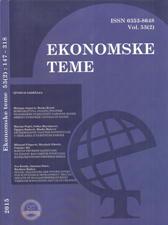Economic Themes (2015) 53 (2) 9, 298-313
Vesna Janjić, Mirjana Todorović, Dejan Jovanović
Abstract: Key features of the current foreign trade of Serbia are high and growing foreign trade deficit, and a small number of export partners. The fact that Serbia places its almost entire export on the markets of Italy, Germany and three former Yugoslavian countries implies the need for export diversification. Finding new or revitalizing former markets is vital for overcoming various weaknesses of Serbia’s foreign trade. Gravity model was used for establishing determinants of Serbia’s export and potential export directions. Coefficients of Serbia’s export, determined in a few earlier studies are based on the figures that were valid before the global economic crisis. As the export to the EU countries which are geographically closest to Serbia decreased during the crisis, it is assumed that the parameters have now changed and the factor of importance of geographical distance decreased. The obtained coefficients are then applied to the countries of the Caspian Basin. This is the region which, due to its numerous geographical and economic characteristics, is seen as an adequate export market, although its distance is relatively large. Research based on applying of gravity model has found that in some countries of the region, there is plenty of „space“ for Serbia’s exports.
Keywords: performance measurement and management models; Balanced Scorecard; SAILS model; GRASP model; Kanji’s model
A COMPARATIVE ANALYSIS OF MODERN PERFORMANCE MEASUREMENT AND MANAGEMENT MODELS OF COMPANIES
Vesna Janjić, Mirjana Todorović, Dejan Jovanović
Abstract: Key features of the current foreign trade of Serbia are high and growing foreign trade deficit, and a small number of export partners. The fact that Serbia places its almost entire export on the markets of Italy, Germany and three former Yugoslavian countries implies the need for export diversification. Finding new or revitalizing former markets is vital for overcoming various weaknesses of Serbia’s foreign trade. Gravity model was used for establishing determinants of Serbia’s export and potential export directions. Coefficients of Serbia’s export, determined in a few earlier studies are based on the figures that were valid before the global economic crisis. As the export to the EU countries which are geographically closest to Serbia decreased during the crisis, it is assumed that the parameters have now changed and the factor of importance of geographical distance decreased. The obtained coefficients are then applied to the countries of the Caspian Basin. This is the region which, due to its numerous geographical and economic characteristics, is seen as an adequate export market, although its distance is relatively large. Research based on applying of gravity model has found that in some countries of the region, there is plenty of „space“ for Serbia’s exports.
Keywords: performance measurement and management models; Balanced Scorecard; SAILS model; GRASP model; Kanji’s model

